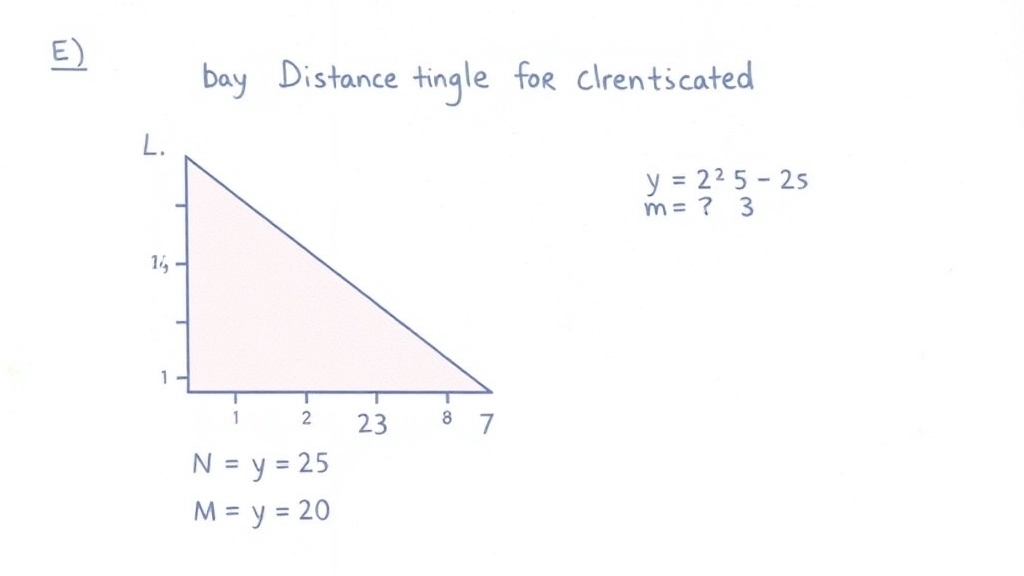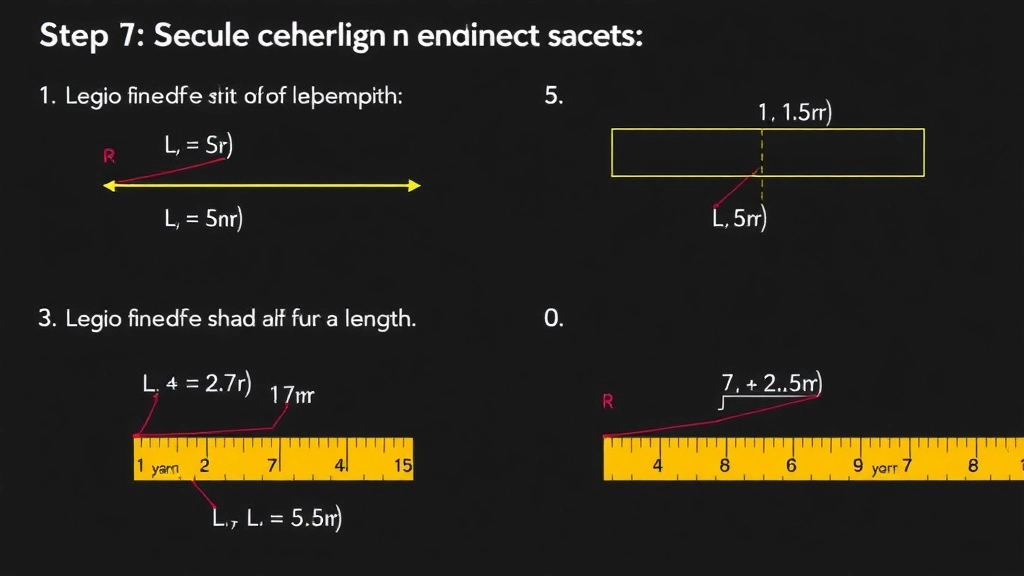Understanding Similar Triangles in Real Life
As a summer camp counselor, you might find yourself in a situation where you need to determine the length between two points, armed only with a few angles and measurements. This article dives into the geometric scenario of using similar triangles to solve for distances, breaking down the key measurements and angles involved. From understanding the basic principles to practical applications in real life, you’ll gain the skills needed to tackle these problems with confidence.
Step-by-Step Calculation
We’ll guide you through the step-by-step calculation of lengths using proportions, highlight common mistakes to avoid, and show you how these principles apply in everyday situations. Whether you’re navigating the wilderness or planning a DIY project, mastering the geometry of similar triangles will be your secret weapon.
Join the Mathematical Adventure
So, let’s embark on this mathematical adventure together and unlock the power of triangles!
Understanding the Geometric Scenario
Alright, let’s dive into this. Ever been stuck trying to figure out the distance between two points but all you’ve got are some angles and a few measurements? Maybe you’re trying to solve a problem for school, or maybe you’re just curious about how geometry can help you in real life. Either way, understanding the geometric scenario is your first step.
Why Does This Matter?
Here’s the thing: geometry isn’t just some abstract math topic. It’s everywhere. From designing buildings to navigating with GPS, understanding the geometric scenario can save you time, effort, and sometimes even money.
The Basics
To get started, let’s break down what we’re dealing with:
- Triangles: These are our main players. They come in all shapes and sizes, but the ones we’re focusing on are similar triangles.
- Angles and Measurements: These are your clues. Think of them as the pieces of a puzzle that, when put together correctly, reveal the whole picture.
Real-Life Example
Imagine you’re standing at the edge of a river, and you need to figure out the distance to a tree on the other side. You can’t just swim across with a measuring tape, right? But if you have some angles and a few measurements, you can use similar triangles to solve this.
Key Points to Remember
- Triangles are your friends: They might look simple, but they hold a lot of power.
- Angles and measurements are your tools: Use them wisely, and they’ll lead you to the answer.
- Real-life applications: From construction to navigation, the principles you learn here can be applied in countless ways.
Common Questions
- “Why do I need to understand this?”: Because it helps you solve real problems, not just theoretical ones.
- “Isn’t this just for mathematicians?”: Nope. Anyone can use these principles, and they’re super practical.
Pro Tips
- Break it down: Don’t try to solve the whole problem at once. Break it into smaller parts.
- Use what you know: Start with the measurements and angles you have, and work from there.
- Practice makes perfect: The more you practice, the easier it gets.
If you’re looking for more ways to apply these principles, check out our Top Math Camps for Summer 2024 for some hands-on learning experiences. And for a broader understanding of how these skills can be useful, don’t miss our guide on the Definition and Benefits of Summer Camps.
Using Similar Triangles to Solve for Distance

Ever found yourself scratching your head, trying to figure out how far something is?
Maybe you’re out hiking and want to know the distance across a river.
Or you’re just curious about how architects measure building heights without fancy tools.
Well, similar triangles are your new best friend.
Similar Triangles: The Secret Weapon
Similar triangles are like the secret sauce in geometry.
They look the same, just scaled up or down.
Same angles, different lengths.
Here’s the kicker: because their angles are the same, their sides are proportional.
Why Should You Care?
Knowing this can save you loads of time and effort.
Imagine not having to cross that river to measure its width.
Instead, you can use a bit of clever math.
Step-by-Step Guide
- Identify the Similar Triangles:
- Look for triangles that have the same angles.
- They could be right next to each other or one inside the other.
- Measure the Known Sides:
- Grab your tape measure or any measuring tool.
- Measure the sides you know.
- Set Up the Proportions:
- Write down the ratios of the corresponding sides.
- For example, if one triangle’s sides are 3 and 4, and the other is 6 and X, you’d set up the proportion: 3/6 = 4/X.
- Solve for the Unknown:
- Cross-multiply and solve the equation.
- In our example, 3X = 24, so X = 8.
Common Pitfalls
- Wrong Angles: Make sure the triangles truly have the same angles.
- Measurement Errors: Double-check your measurements. A small mistake can throw off your whole calculation.
- Incorrect Proportions: Ensure you’re setting up the ratios correctly.
Real-Life Examples
- Architecture: Measuring building heights without ladders.
- Navigation: Estimating distances across rivers or valleys.
- DIY Projects: Figuring out if that new piece of furniture will fit in your room.
Quick Tips
- Use a ruler or any straight edge to help identify similar triangles.
- Always double-check your work.
- Practice with different scenarios to get the hang of it.
Key Measurements and Angles Explained
Alright, let’s dive into the nitty-gritty of key measurements and angles in our geometric scenario. You might be thinking, “Why should I care about this?” Well, understanding these elements is crucial if you want to solve any problem involving similar triangles. Imagine you’re trying to figure out the height of a tree without climbing it. Sounds useful, right? Let’s break it down.
What’s the Deal with Measurements and Angles?
First off, when we’re dealing with similar triangles, we’re talking about triangles that have the same shape but different sizes. They have corresponding angles that are equal and sides that are proportional. Here are the key things you need to keep in mind:
- Corresponding Angles: These are the angles that are in the same relative position in each triangle. If one angle in a small triangle is 30 degrees, the corresponding angle in the larger triangle will also be 30 degrees.
- Proportional Sides: The lengths of corresponding sides are proportional. If one side of the small triangle is half the length of the corresponding side in the larger triangle, this ratio applies to all sides.
Breaking Down the Key Measurements
So, what measurements are we talking about here? Let’s list them out:
- Base: The bottom side of the triangle.
- Height: The perpendicular distance from the base to the topmost point.
- Hypotenuse: In a right-angled triangle, this is the longest side opposite the right angle.
These measurements form the backbone of our calculations.
Important Angles to Consider
Angles are equally important. Here’s what you need to focus on:
- Right Angle (90 degrees): Often a key player in similar triangles.
- Acute Angles: These are the angles less than 90 degrees. In many problems, you’ll be given these or need to find them.
- Obtuse Angles: Angles greater than 90 degrees but less than 180 degrees. Less common in basic similar triangle problems but still worth knowing.
Real-Life Example
Imagine you’re standing next to a tall building. You want to know its height without scaling it like Spider-Man. Here’s what you do:
- Measure your height.
- Stand a known distance from the building.
- Measure the angle from your eyes to the top of the building using a protractor.
By knowing your height, the distance from the building, and the angle, you can use similar triangles to calculate the building’s height. It’s like having a superpower, right?
Quick Tips
- Use a Protractor: Always have one handy for measuring angles accurately.
- Double-Check Measurements: Any error in your measurements can throw off your entire calculation.
- Draw it Out: Visualising the triangles can help you understand the relationships between the sides and angles better.
Understanding these key measurements and angles isn’t just academic; it’s practical. Whether you’re figuring out how tall a tree is or determining the distance across a river, these principles are your toolkit. Keep these basics in mind, and you’ll be solving similar triangle problems like a pro.
For more tips on practical applications, check out our summer camping essentials guide and learn how to apply these principles in the great outdoors. Also, explore our guide to summer camp themes to see how geometry and measurements come into play in various camp activities.
Step-by-Step Calculation of Length Using Proportions

Alright, let’s dive into the nitty-gritty of calculating length using proportions with similar triangles.
Ever found yourself stuck trying to figure out the length of something without a ruler?
Yeah, me too.
But here’s the kicker: you don’t need to be a math whiz to crack this.
Let’s break it down, step-by-step.
1. Identify the Similar Triangles
First things first, you need to spot the similar triangles in your scenario.
Similar means they have the same shape but different sizes.
Think of it like a mini-me version of a triangle.
2. Match Corresponding Sides
Once you’ve got your similar triangles, it’s time to match up their corresponding sides.
This is crucial because we’re going to use these sides to set up our proportions.
3. Set Up the Proportion
Here’s where the magic happens.
You set up a proportion (a fancy word for a fraction) comparing the lengths of corresponding sides.
For example:
Side A / Side B = Side C / Side D
4. Cross-Multiply to Solve
Next, you cross-multiply to solve for the unknown length.
This means you multiply the diagonal terms of your proportion and set them equal to each other.
Simple, right?
5. Double-Check Your Work
Before you pat yourself on the back, double-check your work.
Make sure your similar triangles are correctly identified and your proportions are set up right.
Quick Example
Imagine you have two similar triangles.
One triangle has sides of 3 cm and 4 cm.
The other has one side of 6 cm and you need to find the other side.
Set up your proportion:
3 / 4 = 6 / x
Cross-multiply:
3x = 24
Solve for x:
x = 8
Boom. You’ve got your length.
Common Pitfalls
Watch out for these common mistakes:
- Mismatching sides: Ensure you’re comparing the correct corresponding sides.
- Forgetting to cross-multiply: This step is key to solving the proportion.
- Not double-checking: Always verify your work to avoid errors.
Real-Life Application
Ever tried to measure the height of a tree without climbing it?
Use similar triangles.
Measure the shadow of the tree and a smaller object (like a stick), set up your proportions, and you’ve got it.
Easy peasy.
Common Mistakes When Solving Similar Triangle Problems
Alright, let’s dive into the nitty-gritty of common mistakes when solving similar triangle problems. Trust me, I’ve been there, and I know the pain of getting stuck on what seems like a simple geometry problem.
Why Do We Mess Up?
You might be wondering, “Why do I keep getting these wrong?” Well, you’re not alone. Here are some of the real questions and worries I’ve heard:
- “Why do my proportions never seem to match up?”
- “How can I be sure two triangles are actually similar?”
- “What if I get the measurements mixed up?”
Common Pitfalls and How to Avoid Them
Let’s break down the common mistakes and how you can avoid them:
- Misidentifying Similar Triangles
- Problem: You think two triangles are similar because they look alike, but they aren’t.
- Solution: Always verify their similarity by checking angle measures and side proportions. For more tips on ensuring accuracy, check out our Ultimate Summer Camp Schedule Template Guide.
- Incorrect Proportions
- Problem: Your proportions don’t match up, often due to a simple calculation error.
- Solution: Double-check your calculations and use a calculator if necessary. If you’re planning activities, our Sunshine Summer Camp Programs article can offer some structured approaches to organizing your tasks.
Practical Applications of Triangle Geometry in Real-Life
Ever wondered how triangle geometry can make your life easier?
Or why you should care about similar triangles outside of a classroom?
Let’s dive into some real-world scenarios where this knowledge becomes your secret weapon.
Everyday Uses of Triangle Geometry
Home Improvement:
- Hanging Pictures: Want that gallery wall to look perfect? Use similar triangles to measure distances and ensure everything is aligned.
- Roof Pitch: When building or renovating, understanding the slope of your roof can save you a ton of hassle and money.
Navigation and Mapping:
- GPS Systems: Your sat-nav relies on geometric principles, including similar triangles, to pinpoint your location accurately.
- Surveying Land: Surveyors use triangles to measure distances and plot land, making sure your property boundaries are spot on.
Sports and Recreation:
- Golf: Calculating the distance to the hole? Similar triangles can help you figure out the best club to use.
- Rock Climbing: Understanding angles and distances can keep you safe and help you plan your climb.
Breaking Down Complex Tips
Using Triangles in Photography:
- Composition: The rule of thirds is basically a simplified triangle. It helps you frame your shots perfectly.
- Focal Length: Adjusting your camera’s lens involves understanding angles and distancesâagain, triangles to the rescue.
In Architecture:
- Designing Buildings: Architects use triangles to ensure structures are stable and aesthetically pleasing.
- Bridges: The strength of many bridges relies on triangular shapes to distribute weight evenly.
Real-Life Example: Triangles in Action
Imagine you’re a sailor navigating the open sea.
You need to find your way back to shore.
By using landmarks and understanding the angles between them, you can plot your course accurately.
This method, called triangulation, is a lifesaverâliterally.
Common Mistakes to Avoid
- Ignoring Proportions: Always double-check your ratios.
- Overcomplicating Calculations: Keep it simple. Use basic geometry principles.
- Forgetting Real-World Factors: Remember, real life isn’t a perfect triangle. Adjust for variables like wind or uneven surfaces.
Why This Matters
Mastering triangle geometry isn’t just about passing exams.
It’s about making smarter decisions in everyday life.
From DIY projects to navigating the world, these skills are incredibly valuable.
So next time you face a problem, think triangles.
For more tips on practical skills, check out our essential guide for summer camp leaders and discover various summer camp activities by age to keep everyone engaged.
FAQs on Finding Length Using Similar Triangles
What are similar triangles?
Similar triangles are triangles that have the same angles but different side lengths. This means their shapes are the same, but their sizes are different.
Why are similar triangles useful for measuring distances?
Because the angles are the same, the sides of similar triangles are proportional. This allows you to calculate unknown lengths without needing to measure them directly.
How can I identify similar triangles?
Look for triangles that have the same angles. They could be adjacent to each other or one inside the other. Using a ruler or straight edge can help you identify them.
What is the process to calculate an unknown length using similar triangles?
First, identify the similar triangles. Then, measure the known sides. Set up proportions using the corresponding sides and solve for the unknown length by cross-multiplying.
Can you give a quick example of solving for an unknown length?
Sure! Imagine one triangle has sides of 3 cm and 4 cm, and a similar triangle has one side of 6 cm. To find the unknown side (x), set up the proportion: 3 / 4 = 6 / x. Cross-multiply to get 3x = 24, so x = 8 cm.
What are common mistakes to avoid?
- Mismatching sides: Ensure you’re comparing the correct corresponding sides.
- Incorrect angles: Make sure the triangles truly have the same angles.
- Measurement errors: Double-check your measurements to avoid errors.
- Forgetting to cross-multiply: This step is crucial for solving the proportion.
How can similar triangles be used in real life?
Similar triangles can be used in various scenarios like measuring building heights without ladders, estimating distances across rivers or valleys, and even figuring out if new furniture will fit in a room.
What tools do I need to use similar triangles for measurement?
Basic measuring tools like a tape measure, ruler, or any straight edge are sufficient. No fancy tools are required.
Any tips for beginners?
- Practice identifying similar triangles in different scenarios.
- Always double-check your work to ensure accuracy.
- Use a ruler or straight edge to help identify similar triangles.
References
-
Math is Fun: Similar Triangles
-
Khan Academy: Similar Triangles
-
CK-12 Foundation: Similar Triangles

